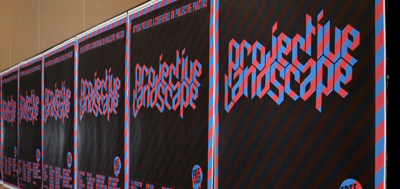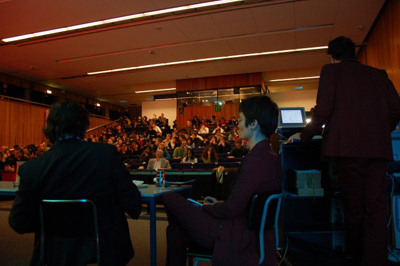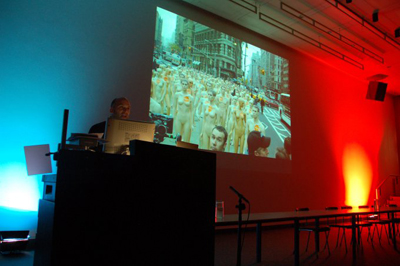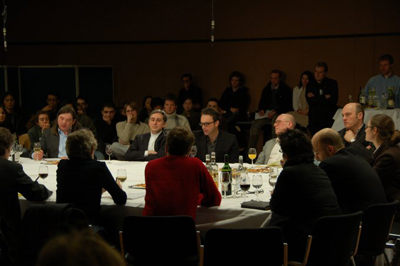
The dust hasn't settled yet but it's about time I informed Archinect about what went down in Delft the 16th and 17th of March. It's a bit strange reporting on an event I myself organized (with a lot of help of course) but perhaps it will bring some unexpected insights.
First It's good to introduce what the actual aim of the conference was:
The Projective Landscape Stylos Conference wants to research and explore the similarities between a few -at first sight- diverse developments within the architecture debate taking place in Europe and the United States. These developments appear to offer a fruitful strategy for architecture in the 21st century. Because this specific debate is very scattered, the conference aims to map and clarify these different developments and hopes to come to a clearer formulation of what now is being referred to as projective practice. By which we mean an architecture that is engaged with the reality of the society in which it is embedded, but focuses on its own discipline instead of looking for legitimatization of its practice in just societal criticism or in disciplines outside itself like sociology and philosophy.For a little bit more extensive problem statement, here is the pdf.
So, let's begin at the beginning. Thursday morning is for the main protagonist who put the whole “projective-post-critical-design-intelligence-performative-after-theory-material-practice” on the agenda. Being: Stan Allen (video), Bob Somol, Sarah Whiting and Michael Speaks. The kick-off was a bid awkward. Somol had the feeling everybody was expecting a party line, a guide book, a how-to-design-projective manual/manifesto. He couldn't repress the image of a show trail or war tribunal when he was sitting in front of the room next to Whiting and Speaks. This attitude of Somol was typical, although everybody had a story to tell, the rhetorical style was defensive and cautious.
 Room A, from left to right: Bob Somol, Sarah Whiting and Michael Speaks.
Room A, from left to right: Bob Somol, Sarah Whiting and Michael Speaks.
Why this caution? One of the reasons I think is that the now seminal article ”˜Notes around the Dopples effect and other moods of modernism' published in Perspecta 33 became a seminal article in the first place, which it never set out to be, according to Whiting. Another is probably the polarization of this debate into very oppositional term such as critical and post-critical, which leaves hardly any room for nuances. But that's one of the main reasons why we organized the conference. Communication just works better face-to-face than via the academic publishing channels.
So far the up beat of the conference. Now I will just deal with a few of the lectures, I can't do them all, that's a bit too much for now but you can watch all the lecture on the
Projective Landscape website via streaming video.
Michael Speaks - Although Speaks doesn't feel comfortable being too much aligned with the ”˜projective' camp, his story is pretty bold and puts him at the extreme end of the spectrum of the conference. His story revolves around the notion that the vastly complex condition of the globalized late-capitalist technologically advanced world. It is futile to search for one truth in this world, instead analyzing, editing, scanning this world can reveal ”˜little plausible truths'. This he calls intelligence, and puts it in a nice chronological scheme from the 18th century to the 21st where the models for finding the ”˜truth' can be successively categorized as philosophy, theory and finally intelligence. Replacing truth with ”˜truthiness' and presenting the book
”˜on bullshit' as a testimony of bringing this notion in to practice.
 Roemer van Toorn in Room A
Roemer van Toorn in Room A
Roemer van Toorn - Van Toorn's lecture was title ”˜Aesthetics as form of Politics' Which is also the shortest summary of the lecture. What is interesting about Van Toorn's story that he sees the projective as a viable model for contemporary architectural practice, but what lacks in his eyes is a agenda which prevents it from slipping into conformation, or how Van Toorn calls it ”˜Fresh Conservatism'.
His argument is an endeavor to read critical societal engagement into the notion of projective as put forward by Somol and Whiting. The architectural project which exemplifies this for him is the Casa da Musica in Porto by OMA.
Hans van Dijk - Van Dijk delivers a cynically harsh but very accurate analyses of the of the debate which inspired the conference. He portrays the ”˜projective' project as an academic transatlantic feedback loop, the same loop from which Eisenman spawned his ideas. The same Eisenman who is the father in the Oedipus complex of today's new generation of architecture scholars. Beside this context Van Dijk shows how the passion for reality has been in part of Dutch architectural practive for the Past 30 years which now has been labeled projective. Finally the mix-up between criticism and critical practice has to be resolved. Practice and Critique are two different jobs, the one for the architect the other for the critic.
Ole W. Fisher - Fischer successfully disarms the projective as an other set of criteria than the ”˜Critical' ones to judge a building with. He discusses the Blur building by Diller + Scofidio and the Weather project by Olafur Eliasson (Tate). By putting every project both next to the critical and the projective yardstick. Critical and projective doesn't seem to exclude each other at all.
M. Christine Boyer - Boyer has a fairly straightforward argument. Already at the end of the first day she was angry and irritated by all the vague terms and non-specificity of the whole projective project. Demanding that people would tell what there project was and to be specific. Her lecture illustrated this simply with the bottom line: ”The U.S.military knows more about the city, does more research, and is better equipped to understand the city than architect and urban planners are ...”
K. Michael Hays - Last speaker before the forum discussion was Michael Hays. For him the job to synthesize the past two days into some conclusions. With his formulation of projective mainly as ”˜intention' the projective project could be pronounced dead or finally classified in a correct category. That projective is mainly an attitude seems close to truth if you put conclusion next to the ”˜Cape Fear' analogy described in Somo and Whitings article.
This is probably what started a lot of the confusion in the first place, namely that the projective wanted to displace the critical. In a sense of displacing the heritage of Peter Eisenman, Yes. But in offering a totally new framework and fundaments to work with in architectural discourse, No. Projective can't displace a theoretical framework like culture theory or critical theory. It doesn't have the ambition to be a theoretical model which has it's own operations, mechanisms and instruments. Projective doesn't want to be theory, it most probably IS practice.
 The final forum discussion
The final forum discussion
In the closing forum discussion Willem Jan Neutelings persistently confronted the American scholars with this reality with the simple question: “What do I with all this Monday morning when I am back at my office?”
NOTE:
All the lecture and discussions are online in streaming video
NOTE:
Check out the photo report of Projective Landscape





1 Comment
hello edwin! i got a question for you...
i spent last summer at a workshop at rotterdam with van Rijs from mvrdv and fell completly in love with the netherlands... i am a 2nd year architecture student in mexico and was told that delft university of technology is a great school to make an international exchange to... i started looking at some stuff and was told that all courses are taught in dutch (which i dont speak a word of)... is that so? is there anyone i can contact about this?
Block this user
Are you sure you want to block this user and hide all related comments throughout the site?
Archinect
This is your first comment on Archinect. Your comment will be visible once approved.